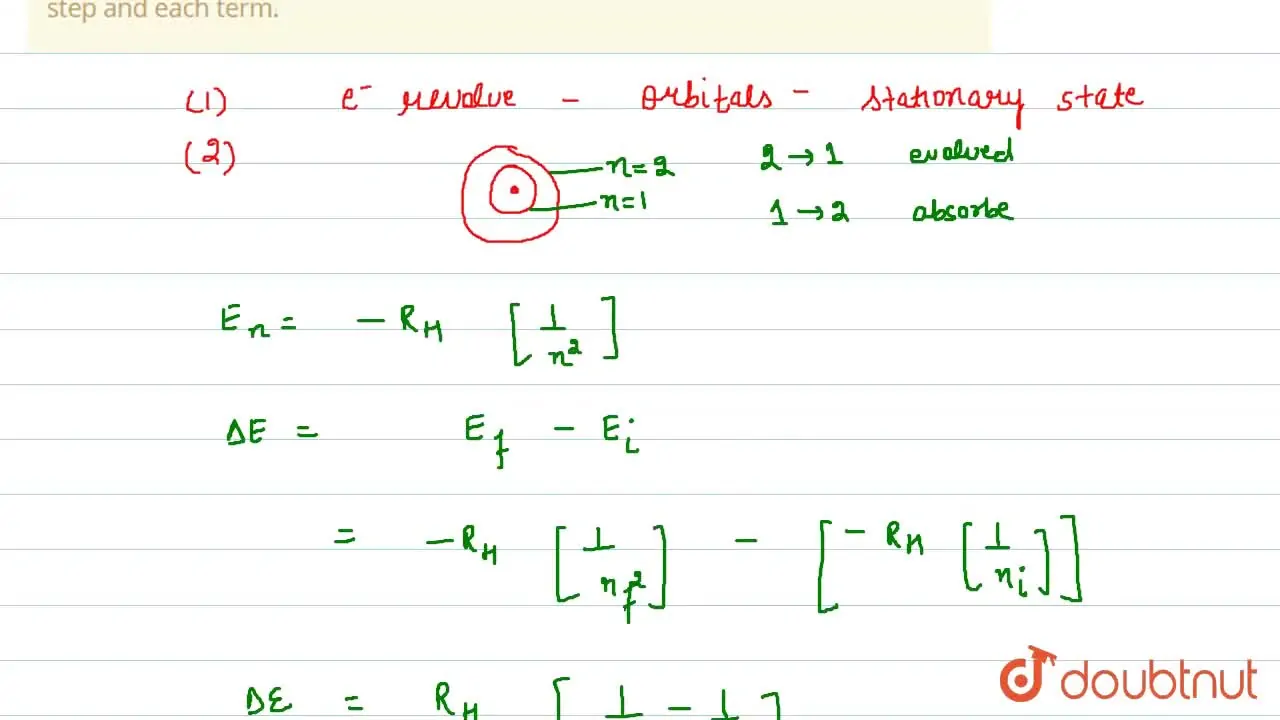When an electric discharge is passed through hydrogen gas, the hydrogen molecules dissociate to produce excited to produce excited hydrogen atoms. These excited atoms emit electromagnetic radiation of discrete frequencies which can be given by the general formula
→v=109677⎡⎣1n2i−1n2f⎤⎦
What points of Bohr's model of an atom can be used to arrive at this formula? Based on these points derive the above formula giving description of each step and each term.
The two important points of Bohr's model that can be used to derive the given formula re as follows
(i) Electrons revovle around the nucleus in a circular path of fixed radius and energy. These paths are called orbits. Stationary states or allowed energy states.
(ii) Energy is emitted or abosrbed when an electron moves from higehr stationary state to lower stationary state or from lower stationary state to higher stationary state respectively
Derivation The energy of the electron in the nth stationary state is given by the expression.
En=−RH(1n2)n=1,2,3
Where RH is called Rydberg cosntant and its vale is 2.18×10−18J. The enregy of the lowest state also called the ground state, is
En=−2.18×10−18(112)=−2.18×10−18J
The energy gap between the two orbits is given by the equation,
ΔE=Ef−Ei
On combining Eqs. (i) and (ii)
ΔE=(−RHn2i)−(−RHn2i) ltbr> Where ni and nf stand for initial orbit and final orbit.
ΔE=RH⎡⎣1n2i−1n2f⎤⎦=2.18×10−18J⎡⎣1n2i−1n2f⎤⎦
Frequency v associated with the absorption and emission of the photon can be calculated as follows
v=ΔEh=RHh⎡⎣1n2i−1n2f⎤⎦
⇒v=2.18×10−18J6.626×10−34Js⎡⎣1ni2−1n2f⎤⎦
v=3.29×1015⎡⎣1n2i−1n2f⎤⎦HZ
⇒→v=vc=329×10153×108ms−1⎡⎣1n2i−1n2f⎤⎦
→v=1.09677×107⎡⎣1n2i−1n2f⎤⎦m−1
→v=109677⎡⎣1n2i−1n2f⎤⎦cm−1
Related Playlists
Similar Questions
When a hydrogen atom is excited from ground state to first excited state, then
View Solutionwhen a hydrogen atom is raised from the ground state to an excited state
View SolutionWhen a hydrogen atom is raised from the ground state to an excited state
View Solutionwhen a hydrogen atom is raised from the ground state to an excited state
View SolutionWhen hydrogen atom is in its first excited level, its radius is
View SolutionThe highest excited state that an unexcited hydrogen atom can reach when they are bombarded with 12.2eV electron is :
View SolutionThe ratio of wavelenghts of photons emitted when hydrogen atom de-excites from third excieted state to second excited state then de-excities form second excited state to first excited state is :
View SolutionThe ratio of wavelenghts of photons emitted when hydrogen atom de-excites from third excieted state to second excited state then de-excities form second excited state to first excited state is :
View SolutionThe electron in the Hydrogen atom is excited to the 5th orbit, the number of spectral lines it is expected to emit is
View SolutionCanal rays produced when hydrogen atoms are taken in the discharge tube constitutes
View Solution


